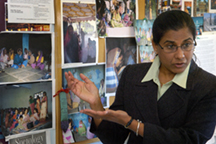
Professor chronicles women's social movements in India
WEST LAFAYETTE, Ind. — The small groups of rural women in India fighting for change is something the rest of the world needs to take note of, says a Purdue University social movements expert.

|
Since the late 1990s, Subramaniam has studied social movements in India, particularly the women's movement in India and the dalit — poor, rural low-caste women in India — as they organized in their small villages. Dalits, also are referred to as the untouchables, and are the bottom of India's caste hierarchy.
The results of Subramaniam's interviews with activists in major cities in India coupled with a case study of rural women will be published this month in "The Power of Women's Organizing: Gender, Caste and Class in India" ($29.95, Lexington Books).
Subramaniam's goal is to encourage debates and conversations about the effects of the women's movement in India by considering the complex and increasingly visible caste and class issues in urban and rural areas. She focuses on the dalit movement and the ways in which the dalit women have visibly organized, nationally and locally, to challenge caste based discrimination.
"I learned so much working on this project," Subramaniam says. "Some people may assume that it was easy for an Indian woman to study other Indian women, but it is not that simple. I see myself as a privileged upper caste Indian woman who had opportunities to attend good schools and an elite college in Delhi as well as travel extensively in India and around the world. I could not make any assumptions about the daily life experiences of dalits."
The caste system, a form of social inequality, was introduced in India several hundred years ago and its origins are a subject of debate. The system is perceived today as particularly rigid and oppressive, Subramaniam says. Members of the lowest caste are considered impure, and are often restricted from entering temples and eateries. For example, dalits don't draw water from the same wells or use the same cups at tea stalls as the upper-middle class. Although denied by people in general, caste is an integral dimension of social structure, Subramaniam says. Many rural Indian villages are structured around caste and religion.
"Because of cultural and historical differences, it would be naive to assume Indian women fight for change the same ways as American and European women did," she says.
Organization and mobilization of social movements can be a challenge because of India's diversity. About 60 percent live in villages with a population of less than 5,000, and two-thirds of the country's population is rural.
In addition to looking at national trends, Subramaniam's book also draws on a local case study of dalit women's groups in rural areas of four districts of the southern Indian state of Karnataka. Bangalore, the Silicon Valley of India, is the capital of Karnataka. Here Subramaniam studied the dalit women's groups called the sanghas, which engage in activities to fight for women's rights and also provide a place where women can raise their self-image and confidence.
Many of the collective protests appear to be small efforts, but they have tremendous effects and changes in these dalit women's lives. For example, Subramaniam visited a village the day of a protest against a caste-related tradition. A local storeowner refused to help dalit women try on bracelets he sold for a local festival. He did not want to touch them because they are dalits and considered impure. The local women organized a protest by sitting outside the store and refusing to move and buy bracelets. Men from the lower caste and women from other villages joined the sit-in, and eventually the store-owner gave in.
"Collective challenges by the women not only create change within the district or village, but individual families as well," Subramaniam says. "Women participants are likely to see changes in their own families. Mothers are fighting for ways to make sure their daughters are educated and are questioning rural traditions such as child marriage."
Subramaniam's background is in physics, international development, economics and sociology. Her work is supported by the College of Liberal Arts and the Department of Sociology and Anthropology.
Writer: Amy Patterson Neubert, (765) 494-9723, apatterson@purdue.edu
Source: Mangala Subramaniam, (765) 496-2631, mangala@purdue.edu
Purdue News Service: (765) 494-2096; purduenews@purdue.edu
PHOTO CAPTION:
Mangala Subramaniam, assistant professor of sociology and women's studies, talks about pictures of Indian women that will appear in her book "The Power of Women's Organizing: Gender, Caste and Class in India." Subramaniam studies women's social movements in India, specifically movements formed by the dalit — poor, rural low-caste women in India. (Purdue News Service photo/David Umberger)
A publication-quality photo is available at https://www.purdue.edu/uns/images/+2006/subramaniam-women.jpg
To the News Service home page